|
|
|
Sort Order |
|
|
|
Items / Page
|
|
|
|
|
|
|
| Srl | Item |
| 1 |
ID:
155455
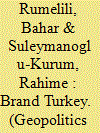

|
|
|
|
|
| Summary/Abstract |
Since the 2000s, Turkish policymakers and private sector interests have combined representations of Turkey as both Western and Eastern with a branding approach to identity in foreign policy, trade and investment promotion, and cultural sector activities. This article analyses how the commodification of its liminal identity as a dual identity allowed Turkey to invoke different aspects of its identity in the West and the East in ways that catered to both audiences and enabled the pursuit of different political and economic objectives. However, the article also notes how this branding strategy was limited by the national identity debates and dominant geopolitical discourses that continued to situate the West and East as mutually exclusive and binary opposite identity markers. Overall, the case of Turkey underscores the complex relationship between branding, identity, and discourse, which has thus far received scant attention in the literature.
|
|
|
|
|
|
|
|
|
|
|
|
|
|
|
|
| 2 |
ID:
087431
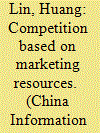

|
|
|
|
|
| Publication |
2009.
|
| Summary/Abstract |
The purpose of this article is to examine the development process of marketing-resources-based competition in the Chinese market by using three case studies of South Korean firms: Samsung, LG, and Hyundai. This study first asks how Korean firms were able to develop a strong market position in China despite their inferior technology relative to Japanese firms and their late entry into the Chinese market vis-a-vis Japanese, American, and European firms. The second question is how Korean firms were able to overcome the challenges of fierce price competition in China and, in particular, how firms were able to evade confrontation with the Chinese firms. In this article, the strategies of latecomers in the global competitive market will be examined. The process of market entry and market position establishment by Korean firms in China will be described. This article also shows how the firms develop branding and marketing communication strategies. Product development capabilities with speed and differentiation are the basis of Korean firms' competitiveness in the Chinese and global markets. The conclusion posits the major findings within the perspective of marketing-resources-based competition and discusses the implications and limitations.
|
|
|
|
|
|
|
|
|
|
|
|
|
|
|
|
| 3 |
ID:
173812
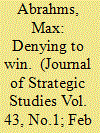

|
|
|
|
|
| Summary/Abstract |
Terrorism carries high audience costs for militant leaders because the attacks on civilians risk tarnishing the entire group as immoral extremists. Image-savvy militant leaders reduce the reputational fallout to the group whenever members commit terrorism. Specifically, the leaders distance their organization from civilian attacks by denying them. In this paper, I identify two types of denial strategies regularly employed by militant leaders, their effectiveness for image restoration, and how Islamic State paid a price for failing to employ them.
|
|
|
|
|
|
|
|
|
|
|
|
|
|
|
|
| 4 |
ID:
101038
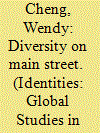

|
|
|
|
|
| Publication |
2010.
|
| Summary/Abstract |
The emergence in the United States of an increasing number of spaces across the socioeconomic spectrum with majority nonwhite populations merits close attention because of these spaces' potential in reconfiguring historical and contemporary claims to place. In an era in which the neoliberalization of urban development has spurred local governments toward more active involvement in defining relationships between race, ethnicity, consumption, and space, "majority-minority" suburbs are particularly important sites of study. In the late 2000s, two branding campaigns in majority-Asian American and Latina/o municipalities in Los Angeles's San Gabriel Valley-a densely populated region popularly known as a "suburban Chinatown"-put forth specific discourses of race, ethnicity, and culture in attempts to actualize specific visions and claims to place, identity, and history. In doing so, these campaigns illuminated and reinforced larger racial, geographic, and ideological divides. "Diversity" on Main Street embraced pluralist multicultural discourses of the nation, while the "Golden Mile" proposal sought to showcase the transformation of a central thoroughfare by ethnic Chinese capital and immigration. A close examination and comparison of these two campaigns shows how struggles over race, geography, and history are intertwined in the contemporary identities of places and integral to the shaping of civic landscapes.
|
|
|
|
|
|
|
|
|
|
|
|
|
|
|
|
| 5 |
ID:
095590


|
|
|
|
|
| Publication |
2010.
|
| Summary/Abstract |
This paper explores the relationship between beers and island development, using a global sweep but with a special reference to the insular Pacific. It adopts a discriminatory approach, touching upon the role and impact that niche and bouquet beer manufacturing can have on the socioeconomic development of small islands. It departs from a personal observation: many small island jurisdictions have their own brewery. Indeed, the brewery could also be the island territory's largest indigenous manufacturing concern. While small islands are associated with low manufacturing capacity and diseconomies of scale, nevertheless 'a local brewery' comes across, in many cases, as a profitable and glaring exception that speaks to the attractions and virtues of locality branding.
|
|
|
|
|
|
|
|
|
|
|
|
|
|
|
|
| 6 |
ID:
144590
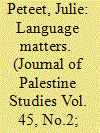

|
|
|
|
|
| Summary/Abstract |
This article explores the linguistic repertoires and conceptual categories that are discursive workhorses in the task of informing U.S. public opinion and shaping policy on Palestine. It situates language commodification in a modern settler-colonial context as it intersects with corporate public relations. The article probes two sites of knowledge production and circulation: the media and the academy. It argues that, ultimately, the media's discursive strategies are handmaidens of violence, enabling and legitimizing colonial relations of displacement and domination. Shifting to academic discourse, particularly anthropology, the article engages with a few selected terms to explore emerging and alternative ways of conceptually framing Palestine.
|
|
|
|
|
|
|
|
|
|
|
|
|
|
|
|
| 7 |
ID:
169163
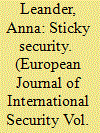

|
|
|
|
|
| Summary/Abstract |
In security studies and beyond, technological developments are associated with technocratic, rationalistic, transparent forms of security governed from a distance. In much of the advertising of tracking devices the associations made are very different not to say opposed to this. The advertising composes security anchored in sensemaking and resonance rather than calculus and reason, working from within and below rather than from a above at distance and depending on the negotiation of opaque co-presences rather than the establishment of precision and transparency. The consequence is that advertising not only extends but also deepens the grip of military/security matters: making them sticky. Moreover, the heterogeneity of the elements is such that what is composed is a shifting collage rather than a stable composition. This argument makes a threefold contribution to security studies: a theoretical reconceptualisation of what it means to compose security, an empirical intervention in the debates surrounding the politics of tracking devices and a methodological intervention in favour of collaborationist research strategies.
|
|
|
|
|
|
|
|
|
|
|
|
|
|
|
|
|
|
|
|
|